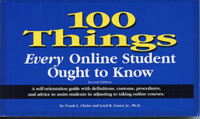Some books are so simple, and so useful in concept, that we really have to wonder why nobody wrote them sooner, and wonder how they escaped notice for so long. 100 Things Every Online Student Ought to Know is one of those books.
 The
methods for delivery of instruction and education have changed, and so have
learners. Not only are there more educational opportunities online, in ever
increasing numbers, but learners themselves are often older than students were ten,
twenty, or thirty years ago. This creates some problems, not only for the
learners faced with a completely different environment from the educational
institutions they knew as "school," but also for the institutions
themselves.
The
methods for delivery of instruction and education have changed, and so have
learners. Not only are there more educational opportunities online, in ever
increasing numbers, but learners themselves are often older than students were ten,
twenty, or thirty years ago. This creates some problems, not only for the
learners faced with a completely different environment from the educational
institutions they knew as "school," but also for the institutions
themselves.
This small manual for adult learners intends to address the mismatches between expectation and experience. While not perfect, it does an excellent job – and it's much better than simply leaving the older learners to shift for themselves, become discouraged, and give up. I also think many of the tips in the book would benefit younger students as well: those who have not formed study habits as well as they might have, and whose online skills may fall far short of what they assume them to be.
What’s so good about this book?
In the 224 pages of 100 Things, there are actually 102 tips, and some extras. These “things” worth knowing begin with the most basic facts about online degree programs and courses (the increasing numbers of them, accreditation, and differences from traditional face-to-face programs). These facts should reassure the student who is doubtful about the quality, validity, and reliability of online institutions and their offerings.
For the students with less online experience (and such students are by no means rare, even today), there are sections that explain online access and communication. But Christ and Ganey go on to address the more critical challenges that can face online learners, regardless of age or online experience: online preparation, satisfaction, and success; online learning and study skills and strategies; how to benefit from online student support; and online "no no's". The book concludes with advice from students who have already successfully dealt with these challenges.
What could be better about this book?
There really isn’t much that the authors could improve or fix, given this book is just supposed to be a basic self-orientation “help” for students, not a complete tutorial. But here are the tiny points that they might address in a future edition.
- Some of the information or terminology is a bit outdated (references to using diskettes for storage, for example). The Glossary is showing its age, too, with some items that were out of date even in 2007 (Netscape Navigator?)
- The “additional resources” section (more reading or references) consists of books that were published as much as 14 years ago – and every one of them is a “dead tree” edition, with not a single online resource listed. Students pay plenty for books as it is, and it is hard to believe that they would want to buy even more books – especially ones that may be out of print.
- To be fair, there is also a lengthy “webliography” but I question how current these resources are, whether they are still available online, and whether there might not be better online resources today (I am pretty sure there are).
- The physical size and configuration of the book isn’t ideal, in my opinion. It’s four inches by seven inches, bound on the short side, and it does not lie flat when opened – really awkward to use. I could argue that it ought to be available online, but that might create an obstacle to its use by some students who need it most. There is now a Kindle version available, but I was unable to review it for possible updates. List price on Amazon for the physical book ($20.30) seems high, but the Kindle version is only $9.95
Bottom line
In spite of its minor shortcomings, in my opinion this would make a good orientation guide for adult students who are uncertain about online education. I believe much of it is too elementary for students who are already familiar with and comfortable with online learning and virtual institutions. However, having said that, the sections on online learning and study skills and strategies, and on how to benefit from online student support, might well be of some value for students with weaker abilities in those specific areas. The concept might also be adaptable for use with training programs in business and government. If you are an online educator, 100 Things Every Online Student Ought to Know is at least worth looking at as a possible resource for your adult learners.
Bibliographic information
Christ, Frank L. and Ganey Jr., Loyd R. (2007) 100 Things Every Online Student Ought to Know, 2nd Ed. Williamsville, New York: The Cambridge Stratford Study Skills Institute. ISBN 0935637303.
Available on Amazon.com: $20.30 for paperback, $9.95 for Kindle Edition (October 4, 2010)
To order the book direct from the publisher:
Peter W. Stevens
President, The Cambridge Stratford Study Skills
Institute
8560 Main Street
Williamsville, NY 14221
www.cambridgestratford.com
cambridges@aol.com
(800) 747-5614 (Voice)
(716) 626-9076 (Fax)


